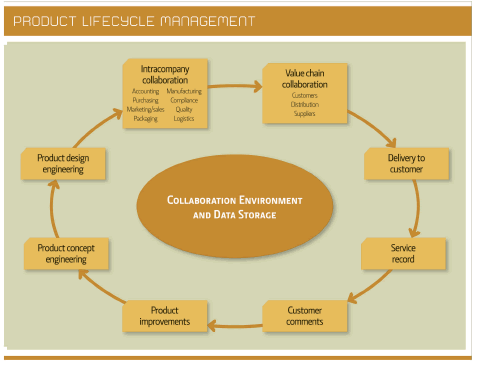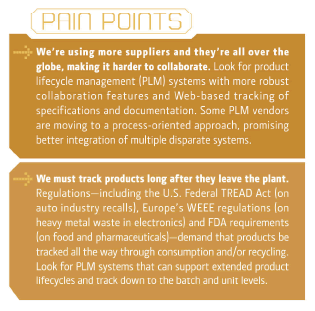Product lifecycle management apps can help you gain control over disjointed activities, but globalization and emerging compliance requirements beg for a more process-oriented approach.


Product development at one time was the purview of a hidden, select group of people endowed with the special ability to envision what customers would buy. These people made product drawings, developed bills of material and invented manufacturing processes. When this "creative" work was finished, the information was sent to other departments for execution.
The trouble with this approach was that purchasing would invariably find required materials were unavailable, manufacturing would end up buying expensive equipment to meet arguable product criteria, and sales would question why the product had to be green when surveys showed white was overwhelmingly preferred. Meanwhile, departmental silos and schedule constraints conspired against revision. In many instances, as much as 70 percent of product cost was determined with little or no input from others.
Product lifecycle management (PLM) systems have brought manufacturers a long way toward introducing order and collaboration to an unaccountable amalgamation of undefined ad hoc input steps, but there's still a long way to go. Managing a product's full lifecycle, from idea to end-of-life, now requires broader collaboration and integration than ever, with globalized manufacturing, rampant outsourcing and emerging compliance demands extending the scope of product lifecycles and compounding complexity. These demands go beyond the capabilities of current tools and require a blending of PLM with capabilities provided by business process management (BPM) and service-oriented architectures.
Design to Disposal
PLM is much more than a software application, and its processes and impact go far beyond product development activity. Similar to the conceptual framework that supports lean manufacturing, PLM is a holistic notion of good management practices focused on the product itself, with these practices crossing departmental and enterprise boundaries. PLM offers many advantages, but three stand out:
PLM provides a real-time environment that supports global stakeholder collaboration from product conceptual design to end-of-life disposal.
PLM can provide a single "version of the truth," with a repository of design revision and design-to-disposal historical information
PLM brings products and related processes under tighter control.
Product lifecycle management is a methodology that uses technology to collect and manage the information associated with a product throughout its life. You may have thought this was the role of CAD systems (or the many computer-aided design, engineering or manufacturing systems that may be used to develop a single product), but these are primarily engineering tools. Product lifecycle information can include design data and material lists from suppliers and their suppliers; bills of material and and their many derivatives and revisions; design-for-manufacturing input; revision history, notes and source data; marketing and sales input; cost accounting data; test and performance criteria; manufacturing process requirements; as-built information, including quality assurance data; regulatory compliance confirmation and certification; and service and use history.
The PLM vision is inclusive, going beyond product development activity to an integrated, cradle-to-grave perspective. The vision is also compelling, making PLM among the fastest-growing segments of the business software market (see "Who's Who in PLM," below). The PLM market, worth $9.65 billion in 2004, grew 10 percent that year and was on track to grow 8 percent in 2005, according to AMR Research.

Full Circle
PLM systems have two distinct but well-connected parts. The first part includes the business processes and tools that bring products to life. The second part encompasses the information specific to a discrete item or batch as the product passes through production, use and end-of-life steps.
Who's Who in PLM?At the start of 2005, what little-known software company had 4 million users, revenue of $1 billion per year, a $3 billion revenue target, a strong vision for its future and was preparing for an IPO? The answer is UGS, a company you've probably never heard of, spun out of Electronic Data Systems in May 2004. What exactly does it do? UGS is a leader in one of the fastest-growing segments of the enterprise software market: product lifecycle management — software that lets people coordinate their work across a process that begins with a product idea and goes all the way to end-of-life disposal. What's driving interest in PLM systems is the intensified march toward globalization, with an average of 20 companies touching any given PLM process. PLM lets you "tie together companies and tap the intellectual resources of China or India," UGS CEO Anthony J. Affuso recently told BusinessWeek. Other vendors in the PLM market include Agile Software, Arena Solutions, CoCreate Software, Dassault Systemes, Fujitsu Siemens Computers, IBM, MatrixOne and PTC. |
From another perspective, PLM has three core components: Authoring includes the mechanical, electrical and software design aspects. In today's global outsourcing environment, this can include information from any number of sources that must be blended into the end product.
Visualization lets users collaborate across a wide range of participants in real time. The primary objective is to provide a current "single version of the truth," with a complete revision history.
Business process support provides a wide range of data about the product unit or batch during and after manufacturing. This includes bills of material, process requirements, engineering change orders, quality assurance and test information, regulatory compliance data, service and warranty history, and improvement suggestions that lead back to authoring (see the "Product Lifecycle Management" diagram).
CAD systems and other authoring tools have been available for many years. It's the extended cradle-to-grave view of the product that makes PLM a useful business tool, expanding horizontally to include wider participation and vertically to include data from more of the processes and events the make up the product lifecycle.
After the Sale
The product information horizon continues to grow. Design discussions with suppliers, online input from customers, engineering change-order management, design for manufacturing, and supplier component tracking are all now parts of a product history. The list also extends to regulatory compliance information, but keep in mind it is not a department or a company that is measured, but each instance of a product.
Who would have thought it would be necessary to track the life of a car part, as now required by the Transportation Recall Enhancement, Accountability and Documentation (TREAD) Act, or to monitor the use of certain raw materials (such as heavy metals), as required by Europe's Waste Electrical and Electronic Equipment (WEEE) regulations.
In another example, the FDA has a requirement to track by lot or batch number the shipment, movement and storage of food products all the way to the retail level to determine when and by whose actions contamination may have occurred. In the medical field, the FDA requires detailed product information through design, manufacturing and use of medical devices and pharmaceutical products.
Automotive manufacturers are building information chains to gather quality assurance information with an eye toward predicting warranty exposure. Thus, a product and each of its versions really can have a life of its own, with a long list of information required, often down to the unit or batch level.
Today's PLM systems do a good job of supporting authoring and visualization activities, with well-defined operational functions such as product change collaboration, product definition and supplier management. It's in the business process support area that requirements have exploded and PLM systems are coming up short. Standard applications simply aren't flexible enough to meet specific process demands to couple and decouple large numbers of disparate systems and information sources.

In the pharmaceutical industry, for example, data must be gathered for each batch of product to comply with FDA requirements. A typical plant can have 25 to 50 disparate applications that contribute information to the master batch record — a document that confirms each step in the product manufacturing process has been performed within guidelines. Historically, drug companies have gathered the output of various applications in paper form and then built master batch records manually. Automating this step would obviously cut costs and give managers an opportunity to correct or prevent problems in near real time, but the stumbling block has been the inability to capture and integrate batch data from dozens of applications.
New Competition
To bridge this information gap, the two most effective solutions are service oriented architecture (SOA) and business process management (BPM) tools. With SOA, one premise is to build Web access into each application to provide information on an enterprise level as necessary for other uses. This is a very good approach, but it's not so easy to implement with a large number of legacy applications that must be connected to the business process. BPM appears to offer more promise for linking data sources and users composite applications that combine information from multiple existing system components.
Despite the success of PLM, the market is headed for change for two reasons:
Platform vendors are getting into the market. For example, IBM and SAP are both moving to include packaged solutions specifically designed for PLM. If these capabilities can be purchased as an extension to middleware or business administration software many enterprises already have in-house, why buy a separate PLM application from a third-party vendor?
Most PLM applications do not scale well for use in multiorganizational processes. The trend is to break down working practices such as design and manufacturing into modules that can be outsourced, which means smaller companies will need to plug into bigger firms' PLM networks. However, PLM vendors aren't providing anything that crosses company boundaries in this way. Again, platform vendors are moving to fill the gap; Microsoft and Oracle, for example, are enhancing the collaboration facilities with Windows Workflow Foundation and Oracle BPM, respectively.
A Process Perspective
Given the big demand for PLM, you wouldn't expect market experts to be saying, "I'm not sure PLM will survive as a standalone category," but that's what PLM guru Navi Radjou of Forrester Research recently told The Economist Technology Quarterly.
Radjou believes PLM functions will be broken down and bundled into other applications, such as supply-chain management systems and even desktop productivity software. This fits a generalized technology trend in which major packaged application vendors are breaking their offerings into small, independent pieces that can be linked together as desired using process orchestration and Web services. SAP, for example, presents NetWeaver as a way to construct your own business processes using components from its package. Similarly, the Oracle Fusion Architecture for the latest versions of Oracle's application suite emphasizes process orchestration.
Even desktop productivity applications are headed in this direction. Microsoft is incorporating its Workflow Foundation directly into Windows, while the new breed of desktop applications gaining traction are not suites but small, focused tools aimed at facilitating collaboration, such as Skype and Groove.
Why? A universal recognition is developing that taking a process approach to software support is valuable for many reasons — in particular, the ability to support changing business requirements, since a process can be altered far more easily than a monolithic packaged application. A process created using a BPM tool typically can be modified using a graphical modeling tool that lets users add, change and remove activities as required.
So PLM is likely to go down the process route as well. Process-oriented PLM will be implemented using tools that link pieces of server-side functionality with small desktop applications. PLM vendors such as Agile Software, Fujitsu Siemens Computers and Ingenuus Software are releasing new product versions with specific support for BPM.
Meanwhile, SOA techniques make it possible to connect pretty much anything you want into a single business process, including legacy applications, PLM modules from different vendors and custom applications. So why buy everything from one PLM supplier if you can mix and match, reusing existing IT resources where you can and choosing best-of-breed for each module where you can't?
Beyond PLM
PLM is entering the enterprise application mainstream. It makes it relatively easy to quantify returns and justify investments. Users embrace the PLM workspace because it helps them collaborate and have access to the right information at each stage of a product's lifecycle. Tighter product control and related processes tops nearly every manufacturer's list of objectives.
It's hard for those who've implemented PLM to imagine how they managed without it, and the need for it is quickly evolving. Globalization, outsourcing, regulatory compliance and demands for greater flexibility are leading the way toward more process-oriented answers for product lifecycle management. In the short term, that means process-enabled PLM systems. The long term may bring more dynamic and granular combinations of applications, processes and PLM-like functionality built into IT infrastructure.
There are even those who envision new forms of technology for "human-interaction management" (see "Opinion: It's Time for a New Approach"). One thing is certain: The days of poorly defined, uncontrolled, ad hoc and disconnected product development are over.
Michael McClellan is President of Collaboration Synergies Inc. (www.cosyninc.com) and author of Collaborative Manufacturing: Using Real-time Information to Support the Supply Chain. Write to him at [email protected].
Keith Harrison-Broninski is a consultant, software developer and author of Human Interactions: The Heart And Soul Of Business Process Management. Write to him at [email protected].
Opinion: It's Time for a New Approachby Peter Fingar Large PLM projects between a few tightly connected trading partners are giving way to smaller, more specialized and dynamic initiatives among many smaller, specialized players scattered across the globe. As this trend continues, the focus of PLM must shift from the application to the process. Here's why. If you are a product manager with hundreds of brands and products, that adds up to thousands of tweaks per year, touching large and small trading partners scattered from San Diego to Shanghai and Chicago to Chennai. PLM processes must be bundled, unbundled and rebundled in response to changing market realities and customer needs. The critical challenge in synchronizing the work involved with global PLM is those darned 20 percent exceptions that must be dealt with by human beings — thereby consuming 80 percent of resources. The shortcomings of workflow technologies have led to new developments over the past five years, many coming under the banner of business process management (BPM). Most of today's BPM solutions can take care of 80 percent of the routine, predetermined system-to-system scenarios, combining predefined workflow and interapplication transaction management. BPM brings order to system-to-system interactions, but it still doesn't directly support the way people actually work. What's needed is a technology that can support dynamic, human-to-human interactions that cannot be preordained or preprogrammed like system-to-system interactions can. This kind of dynamic process change is not easily facilitated in today's workflow, BPM, knowledge management or collaboration solutions, but that's starting to change. Leading vendors are moving toward direct support for human-to-human work processes. Microsoft is embedding workflow into the next generation of Windows, and Office 12 is being promoted as a human interaction system to manage what Bill Gates calls the "New World of Work." IBM's Workplace technology provides support for person-to-person communication and role-based collaboration. And process is a core abstraction of Metaphors, the next-generation replacement for Java from Sun Microsystems. These vendors are working toward what computer scientist Keith Harrison-Broninski describes as a Human Interaction Management System (HIMS), a software engine for defining, facilitating and managing collaborative human work processes. First-generation HIMS may be little more than a fusion of existing collaboration, knowledge management, workflow and BPM technologies, but as Harrison-Broninski points out in his book, Human Interactions, a comprehensive and adaptive system must facilitate the five main stages of human work: research, evaluate, analyze, constrain and task. Most systems today only account for the task stage. These stages can't be modeled because humans don't work like machines. Harrison-Broninski proposes managing human work using a combination of techniques. Role activity diagrams can be used to map communications between process participants and detail underlying context. Complex problems can be broken down into a series of simpler ones and managed with guiding patterns (depicted in the activity diagrams and modified as needed). Preconditions and postconditions (or "agreements") can be associated with tasks and interactions so they can be performed in any sequence, supporting a flexible, human style of work. This is a high-level overview of what I believe to be a breakthrough approach. A well-managed workspace environment would be a stark contrast to the current chaos of e-mail, faxes, meetings, phone calls, instant messaging and disparate content management and collaboration solutions. It's time for vendors to embrace (and technology users to demand) a next-generation approach. Peter Fingar is a business process management expert and author of Extreme Competition: Innovation and the 21st Century Business Reformation. Write to him at [email protected]. |
About the Author(s)
You May Also Like







